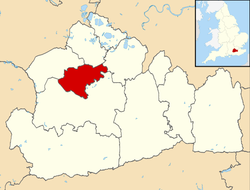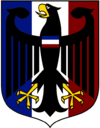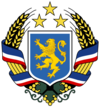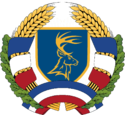Dale Republic
This article refers to a micronation or element of micronationalism which is defunct and no longer exists. You can help make the article reflect that or ask on the talk page for further information. |
Dale Republic | |
|---|---|
 | |
| Capital | Woking City |
| Official languages | English |
| Demonym(s) | Delsh |
| Legislature | Dale Assembley |
| Establishment | 2 June 2015 |
| Population | |
• /99,426 (mid-2014 est.) census | 16 (Peak) |
| Currency | Great British Pound |
The Dale Republic was a European micronation founded by some of the former citizens of previous Woking micronations such as the Kingdom of the Dale Empire, the original Dale Republic, Grand Empire of Knaphill, the Surrey Democratic Republic, the Republic of New Dale and the Delsh-Westlandian Federal Republic. The Dale Republic was administrated from the southeast of England, but while it did not designate any territory or a capital city for the revived micronation it was suggested to still exist within the territory of the previous micronation to share its name between 2011-2012. The reformed Dale Republic was the first Dale-Woking micronation since the collapse of the Republic of New Dale on May 18, 2014 and the reformed Dale Republic was established 948 days after the formal dissolution of the original Dale Republic which existed between 2011 and 2012. The reformed Dale Republic was replaced by the Dale Commonwealth within a year, but is largely considered to be the final Dale-Woking micronation as the Dale Commonwealth was not treated as a fully fledged state.
History
  | |
| Pre-Dale History | |
|---|---|
| England (927 - 1707) | |
| Kingdom of Great Britain (1707 - 1801) | |
| United Kingdom (1801 - 2011) | |
| Dale History | |
| Kingdom of the Dale Empire (22 May 2011 - 22 Sept) | |
| Dale Transitional Council (22 Sept - 26 Oct) | |
| Dale Republic (2011-12) (26 Oct - 26 Oct) | |
| Grand Empire of Knaphill (21 Oct - 26 Oct) | |
| Surrey Democratic Republic (26 Oct - 2 Nov 2012) | |
| Republic of New Dale (21 Mar 2013 - 18 May) | |
| Dale-Westland (11 July - 18 May 2014) | |
| Dale Republic (2 June 2015 - 29 Feb 2016) | |
| Dale Commonwealth (1 Mar - 9 Nov 2016) | |
| Portal | |
| Dale Portal |
Kingdom of the Dale Empire
The first Dale-Woking micronation was the Kingdom of the Dale Empire, based in Woking but claiming territories on every continent. The Kingdom of the Dale Empire was an absolute monarchy, ruled by King D Sherman from 22 May to 22 September 2011. While it is the official period of the Dale Empire there have been unconfirmed suggestions that historic Dale could have been founded in as early as either 2008 or 2009, although little actual evidence has been provided to prove this theory it has at times been treated as part of Dale's wider history albeit as a separate history from the recognised Dale-Woking micronational history. The two entities had historically been treated separately due to the no direct continuity of histories between the micronations. However, within months of the formation of the monarchy there had been suggestions that the state may transition to an alternative form of governance to encourage greater engagement of its fledgling citizenship. Between the 7th and 8 September 2011, there was a poll on the MicroWiki forum which was used to help inform on the potential the future of the Dale Empire on whether it was to remain a monarchy or to become a republic. However, because the poll ended in a tie it was left to a random name selector which selected the Dale Republic to be the victor of the political change.
Dale Republic
During the official switchover from the Kingdom of the Dale Empire to the Dale Republic a transitional government was formed, the Dale Transitional Council, to oversee the transferring of power from the king to a newly elected government. The transfer of authority from the monarchy to the transitional government took place on the 22nd September 2011. This date was chosen to coincide with the 4-month anniversary of the Kingdom of the Dale Empire's founding. The Dale Transitional Council held power for 35 days and oversaw the first Dale Presidential election held over a multi-day period before authority was transferred from the Dale Transitional Council to the Dale Republic with the Dale Assembly, later called the Dale Montering, becoming the legislature of the Dale Republic on 26th October 2011.
The first President of the Dale Republic was elected on the first day of the Dale Republic and was won by D Sherman of the Woking Independence Party, later renamed to the Woking People's Nationalist Party. He served his entire 6-month term as outlined in the Dale constitution. The second Dale elections were held in April 2012. This time D Sherman lost the election to James Hunt of the Liberal-Conservative Party. However, he soon resigned after just 3 days from this position. This event led to a dispute over how his resignation should be handled, while some believed his deputy, Daniel Townend, should continue the remainder of his term, almost a complete term, others believed a new vote should take place and Daniel should only be able serve as the interim president until a new election could be held. This led to a number of disputes and even near hostilities between some citizens of the Dale Republic. A by-election was eventually held in May 2012 and James Hunt successfully regained his position as President of the Dale Republic just 2 weeks after his resignation.
Collapse of Dale-Woking micronations
Despite James Hunt regaining his position as president there was still instability within the Dale Republic caused by the unclear circumstances that led to the domestic crisis due to the failure of the constitution to account for how to manage in the event of resignation as well as disagreements in the role and powers of the President of the Dale Republic and the Dale Montering. It became unclear where the executive authority lay within the republic and unclear direction of how to rectify this. These factors quickly assisted in the decline of the Dale Republic and eventually, the micronation fell into a degree of inactivity. After a largely failed attempt at returning activity to the Dale Republic, D Sherman declared the Grand Empire of Knaphill as an independent breakaway micronation occupying a western portion of territory previously of the Dale Republic. This succession was accepted by the Dale Republic upon its declaration on October 24, 2012. However, the Grand Empire was short-lived after the Dale Republic itself collapsed on October 26, 2012. Following this, the Grand Empire of Knaphill declared a unified Woking micronation under a new socialist state, the Surrey Democratic Republic.
As well as reunifying the Woking under a single micronation, the Surrey Democratic Republic claimed additional territory for the larger Guildford borough, more than doubling the total claim. Despite this restructuring, the Surrey Democratic Republic itself would fall into inactivity due to a smaller active population which limited its ability to function domestically. The Surrey Democratic Republic was not formally disestablished but was replaced following a restructuring that would see the re-establishment of a Dale-Woking micronation on 21 March 2013.
Republic of New Dale
After the Surrey Democratic Republic fell into inactivity and other failed attempts to restart, an agreement was finally met on March 21 to found a new democratic Woking-based micronation. After some debating and voting, it was finally agreed on the 25th for the Republic of New Dale to be established at the new Dale-Woking micronation and formally replace the Surrey Democratic Republic. The Republic of New Dale would be a direct democratic micronation with a president serving in a largely ceremonial role. Presidential voting which started on March 31 and ended on April 1 where D Sherman was elected as the first President of New Dale. While the Republic of New Dale had been agreed on March 25 and a new president elected on April 1 the claimed territory of the new Dale-Woking micronationa had not been confirmed. Responsibility for proposing this was given to the President despite their largely ceremonial role and this would then be voted for by the people of New Dale. It was also decided at the time that the new president would have only 1 month to complete this before a new presidential vote for a primarily ceremonial President of New Dale. In the end, the decision was made that the Republic of New Dale would claim the whole of the administrative county of Surrey from England. Woking would remain the micronation's capital.
On May 2 2013 D Sherman was reelected President of the Republic, however with 2 citizens leaving and only 3 out of the remaining 5 citizens voting it was proposed by the president that New Dale should consider entering a political union as a means of increasing its population and domestic activity and a referendum was quickly started. This vote was done in the New Dale sovereignty referendum, the poll which ran for 2 days, between May 3 and 4 2013. However, when the referendum reached its conclusion only one vote had been cast, that of the President. This result was used as a reason to justify New Dale's new goal to seek a political union with another micronation, even though it received such a small turnout. After a few failed attempts at negotiations and even some reconsideration towards the idea of merging the Republic of New Dale was eventually contacted by the Republic of Westland who were considering disestablishment because of similar issues regarding inactivity. An agreement was eventually reached on July 11 2013 as the two agreed to merge and formed the Delsh-Westlandian Federal Republic.
Delsh-Westlandian Federal Republic
The Delsh-Westlandian Federal Republic was founded on July 11 2013. The new British micronation adopted a federal structure that kept the Republics of New Dale and Westland as autonomous republics within the new federal republic. Each would receive a high level of autonomy to deal with any and all internal matters while federal matters that impacted both republics or the federal state itself were the responsibility of the newly created federal government. The elections were held to decide the President of the Federal Republic as well as the First Ministers of both New Dale and Westland, these three positions would form the federal government, known as the Federal Parliament. When the first election was approaching no political parties were created in the Republic of New Dale, this decision was largely influenced by the troubles experienced during the latter months of the Dale Republic. Without political parties, both individuals who ran for political positions within the federal republic, D Sherman and J.H., did so as independents. They would later create a joint political party, the Federal Part of Dale-Westland
On July 21, 2013, both were elected to separate positions, James Hunt was elected the first Delsh First Minister, and D Sherman was elected the President of the Federation. On September 22, 2013, territory from Guildford Province which consisted of the City of Guildford was donated by the Republic of New Dale to the Federal Parliament in order to create the Guildford Federal City. The Guildford Federal City would become the capital of the Delsh-Westlandian Federal Republic and was no longer treated as a territory of New Dale. Instead becoming a federal territory held in trust by the Federal Parliament. However, much of its day-to-day running remained partially administrated by New Dale through the creation of the joint legislature, the Dale-Guildford Council. Following a long period of declining activity in the Republic of New Dale and the Delsh-Westlandian Federal Republic as a whole it was decided that New Dale would dissolve.
Reformed Dale Republic
Since the dissolution of the Republic of New Dale the idea to establish a new Dale-Woking micronation to rekindle the historic days of the Dale Republic had long been floating around, almost without a real intention to do so based on the historical issues relating to Dale-Woking micronations. However, on June 1 2015 former New Dale First Minister D Sherman proposed an idea to several former citizens to test public opinion. However, the idea quickly gained support from former Dale Republic citizens and eventually the proposal to establish the new Dale Republic was supported by what was considered a reasonable minimum of citizens, but with considerations such as schedules and lifestyles having to be accommodated the previous representative democratic system was seen as unsuitable so an entirely new system had to be created from scratch. The system described as "a non-partisan directional Republic with legislation passed by popular vote", inspired to a degree by the government system of Switzerland was chosen and immediately found support among the now citizens of the reformed Dale Republic, with elections for the new Dale Assembly being scheduled for the first weekend after reformation using a voting system of cumulative voting.
The elections ended with expected candidate Eamon Ali winning by a significant majority of the votes, 14 of the 25 votes cast, and being elected President of the Dale Republic. Second came D Sherman and in joint third were James Hunt and Chris Barnes, requiring a run-off vote to decide the 3rd seat. However, immediately after announcing the results of the election D Sherman stepped down from his newly elected post in the Dale Assembly in favor of avoiding a run-off vote and allowing both James and Chris to both sit in the Dale Assembly. However, friction quickly formed over the handling of administration rights of the nation's main communication network. Despite winning the election Eamon was denied admin rights by other members of the Dale Assembly, with opponents citing the lack of need in these powers given his role as chair of the collective head of state that was the Dale Assembly. However, the majority of the Dale population voted in favour of Eamon obtaining admin rights which the Dale Assembly would eventually give to him.
The situation worsened as this incident and an earlier event regarding the awarding of citizenship to an undesired person resulted in a divide Dale Republic citizenship once again which later unfolded into a coup d'etet by dissatisfied citizens, calling themselves the Revolutionary Council of Dale and seeking to install a pro-direct democracy constitution which lead to many supporters of the ousted President to leave the Dale Republic in solidarity with him. The stand-off between the revolutionaries and the exiled supporters who wanted to pressure the revolutionaries into recognising a breakaway state from the Dale Republic, while the revolutionaries wanted to reform the Dale Republic into a federal state with each party given equal autonomy. The stand-off between the two sides lasted 34 days before a peace agreement between the parties saw neither goal achieved and instead saw the Dale Assembly being abolished and James Hunt installed as acting president of the Dale Republic with a new election planned for a later date. However, these were never held.
Following the completion of peace plans political activity declined in the Dale Republic as it took a more significant social role, outside that of politics, with control over the Dale Republic becoming a grey, unclear topic, but with all citizens content with the status quo that had formed, little had been done to create another upheaval, this had led to a system of effective anarchism, without an official change in system the change had occurred naturally to an anarchy system without any form of state control over the Dale Republic.
Government
| Dale Republic |
 This article is part of the series: |
|
|
| Government President |
|---|
|
Elections
Executive
President: None (Effective Anarchy)
|
The Dale Republic was a direct democracy and while having both a president and a legislature, neither held any executive power. Instead, both were responsible for the organisation of elections, public consultations, and popular referendums. Executive authority was instead held by the citizens of the Dale Republic who would vote on matters presented to them by the Dale Assembly.
Presidential Branch
The President of the Dale Republic served as the primary representative of the Dale Republic to the wider micronational community and regularly engaged in diplomatic business on behalf of the Dale Republic.
Legislative Branch
The Dale Assembly was the legislature of the Dale Republic. The Dale Assembly was made up of 3 sitting members at any one time. These assembly members were elected to their positions in elections held every 6 months, during their time in office they would also serve as the heads of the Dale Republic's 3 government departments in order to take their parliamentary seats. The departments of the Dale Republic consisted of the Department of Internal Affairs, the Department of External Affairs, and the Department of Culture, Media, and Sport.
The Assembly had the power to decide the direction of domestic and foreign policy; approve or amend the constitution; declare war on another state; ratify or annul international treaties; and control the activity of state radio and television, state news agency, and other official information media.
Administrative divisions
The Dale Republic was divided into 9 districts, encompassing 3 cities, 6 towns, and 11 villages. The cities in alphabetical order were the City of Knaphill, the largest population center outside of the capital, the City of St. John's, granted city status for its historical connection to the Dale Republic's past as the birthplace of its predecessor, the Dale Empire and Woking City, the capital city of the Dale Republic. After the 3 cities are the 6 towns that acted as the seats for the other districts of the Dale Republic, these were Byfleet, Goldsworth, Mayford, Old Woking, Horsell, and Pyrford, and finally, the 11 villages were the last division of population areas and are the smallest, including their district these are West Byfleet in Byfleet, Brookwood, Hook Heath and Sutton Green in Heathlands, Kingfield and Westfield in Hoe Valley, Maybury, Pyrford Green, Pyrford Village and Ridgeway in Pyrford and Sheerwater in Woking City.
 |
No. | Flag | Name of district | District seat | Area (km²) |
Population | Population density (Pop. per km²) |
Cities/ Towns/ villages | |
|---|---|---|---|---|---|---|---|---|---|
| 1 | Byfleet | Byfleet | N/A | N/A | N/A | 2 | |||
| 2 | Goldsworth Park | Goldsworth | N/A | N/A | N/A | 1 | |||
| 3 | Heathland | Mayford | N/A | N/A | N/A | 4 | |||
| 4 | Hoe Valley | Old Woking | N/A | N/A | N/A | 3 | |||
| 5 | Horsell | Horsell | N/A | N/A | N/A | 1 | |||
| 6 | Knaphill | City of Knaphill | N/A | N/A | N/A | 1 | |||
| 7 | Pyrford | Pyrford | N/A | N/A | N/A | 5 | |||
| 8 | St. John's | City of St. John's | N/A | N/A | N/A | 1 | |||
| 9 | Woking City | Woking City | N/A | N/A | N/A | 2 | |||
| Total | Woking City | 63.6 km² | 99,198 | 1,550 | 20 |

